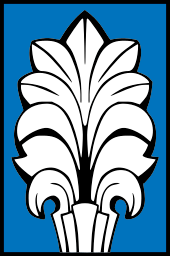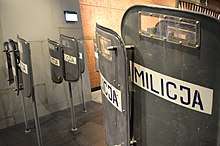Milicja Obywatelska

Milicja Obywatelska (Polish pronunciation: [miˈlit͡sja ɔbɨvaˈtɛlska]; Citizens' Militia), commonly abbreviated to MO, was the national police organization of the Polish People's Republic. It was created on 7 October 1944 by the Soviet-sponsored Polish Committee of National Liberation, effectively replacing the pre-war police force.[1] The Citizen's Militia would remain the predominant means of policing in Poland until 6 April 1990, when it was transformed back into Policja.[2]
The term milicja had been adapted from the cognate term, militsiya, used in several communist countries. The term is derived from militia, which in turn claims its etymology from the concept of a military force composed of ordinary citizens. Contrary to implied meaning, in most cases it represented rather a state-controlled force, used to exert political repression on the citizens.
Under both communist and post-communist governments, the Polish police system has traditionally operated under the auspices of national authority. Starting at the end of World War II, Poland fell under the influence of the Soviet Union, especially in 1947 and later in 1952, when the country's turn toward Stalinism brought the beginning of totalitarian rule. The highly centralized nature of the militia and its lack of any great power placed it largely under the control of the Security Bureau, which used it to instill fear in the local populace. The general training was offered in the town of Legionowo.

Organisation

The Citizens' Militia was divided into a Public Order Department, Traffic Militia (Highway patrol), Criminal Investigations (Major crimes, forensics), Investigations Militia and an Infrastructure Security Section (Security of government buildings, airports, installations).
There were regional, district, city and local detachments of the force.
The ZOMO motorized riot troops, which played the most visible role in quelling demonstrations in 1980 and 1981, were reduced in size somewhat by the early 1990s and renamed Preventive Units of the Citizens' Militia (Oddziały Prewencji Milicji Obywatelskiej—OPMO). OPMO forces are restricted to roles such as crowd control at sporting events, ensuring safety in natural disasters, and assisting the regular police. In theory, higher government authority would be required for large OPMO contingents to be used.[3]
From the 1960s through the 1980s, ORMO forces, which at one time numbered as many as 600,000 civilian volunteers, were used to augment regular police personnel at key trouble spots. In the early 1980s, ORMO harassed Solidarity members and prevented independent groups from organizing. Largely staffed by industrial workers who gained substantial privileges by monitoring their peers in the workplace, ORMO was the object of extreme resentment throughout the 1980s. Kiszczak attempted to promote ORMO as a valuable auxiliary police force, but the organization was abolished by the Sejm in 1990.[3]
Transportation
The most common types were:
- FSO Warszawa MO car
- Restored Polski Fiat 125p and Nysa 522 RSD Milicja Obywatelska vehicles
 FSO Polonez MR'78 militia car in Poznan 2011
FSO Polonez MR'78 militia car in Poznan 2011- Restored FSO Polonez MR'83 and Nysa 522 RSD of Citizens' Militia of Polish People's Republic (from the reenactment group milicja.waw.pl)

See also
References
- ↑ Czubacki, Jacek. "Powstanie Milicji Obywatelskiej 7 października 1944". Historia zapomniana i mniej znana. Retrieved 20 March 2018.
- ↑ "Act of 6 April 1990 on the Police" (PDF). Policja.pl. Policja. Retrieved 20 March 2018.
- 1 2 http://lcweb2.loc.gov/cgi-bin/query/r?frd/cstdy:@field%28DOCID+pl0277%29
| Wikimedia Commons has media related to Citizens' Militia in People's Republic of Poland. |